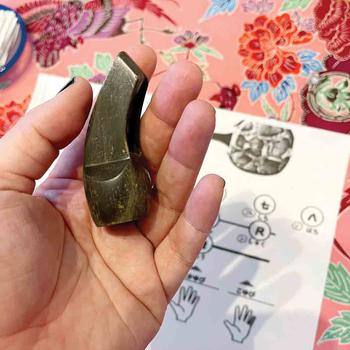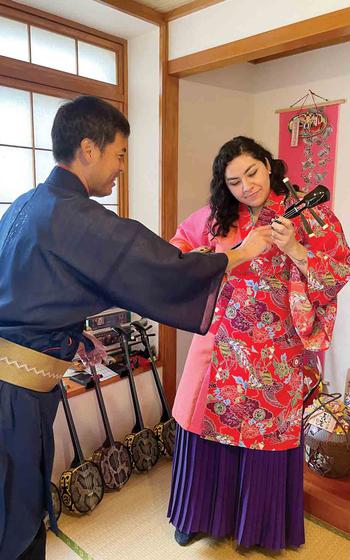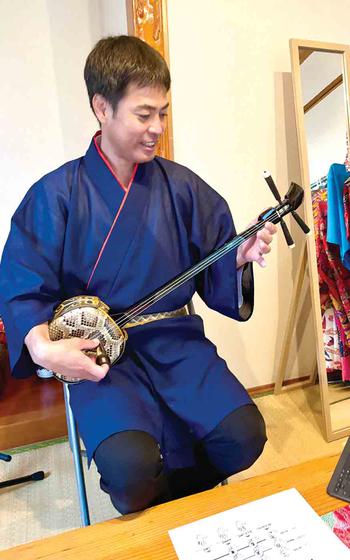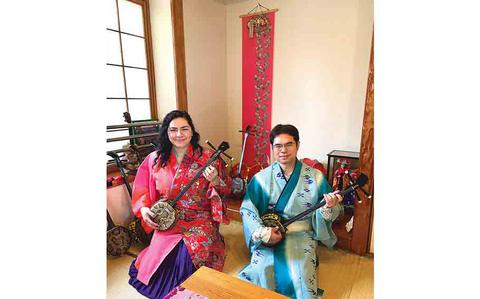
(Photo by Shoji Kudaka/Stripes Okinawa)
Do you know about sanshin? The three-stringed musical instrument of Okinawa looks and sounds like the shamisen of mainland Japan, but this snakeskin-covered Ryukyu instrument has some differences you can learn about in a short workshop in Mihama American Village.
Many Okinawans are familiar with the sanshin, although the years of practice it takes to master it means it is not very common to play it.

(Photo by Shoji Kudaka/Stripes Okinawa)
I was one of those Okinawans who was satisfied with just listening to the strums of sanshin music and had never picked one up to learn.
However, a recent visit on a rainy day with my editor to Utwuimuchi-Project changed that. Utwuimuchi-Project is a shop for Okinawa cultural experiences like music, dance and other activities.
“Here, you can have fun from the get-go,” said Kyuuna Morimitsu, who hosts the shop near American Village, as he greeted us.
Utwuimuchi means “hospitality” in the Okinawan dialect. As its name suggests, this is a place where tourists and visitors from outside can come and experience local culture.
But I found that it was also a great place for a novice Okinawan like me.
Kyuuna ushered us into a tatami room adorned with traditional fabrics and figurines. Before the lesson started, he treated us to a glass of sanpin tea and Kokuto (brown sugar), a common way to welcome guests in Okinawa.
Soon, the instructor passed us a sanshin and began showing us how to hold the instrument and how to pluck a string. We were also given a buffalo horn pick that covered our index finger to make it easier to pluck each string. The neck of the instrument had points marked for finger positions, so we could start playing the instrument in no time.

(Photo by Shoji Kudaka/Stripes Okinawa)
Learning to play
Normally, playing sanshin would require reading kunkunshi, Okinawan notation in kanji, which can be challenging for beginners like us. However, Kyuuna translated it into sol-fa syllables, which was very helpful.
Learning how to play 12 basic notes (one octave plus four notes) would suffice to play many numbers, according to Kyuuna.
To play the sound of “so,” we pressed down the middle string with the index finger at the top point of the neck.
Unlike the guitar, with which you would pluck several strings to sound a chord, we were told to pluck one string at a time. Following our instructor, we plucked one sound at a time for tuning.
Although Kyuuna mostly spoke Japanese, he was very good at getting the point across by utilizing gestures and diagrams. Plus, his friendly personality made us feel at home.

(Photo by Shoji Kudaka/Stripes Okinawa)

(Photo by Shoji Kudaka/Stripes Okinawa)
Strumming along
Once his lecture on the basics was over, Kyuuna encouraged us to play some simple songs.
The first was “Twinkle, Twinkle, Little Star.”
Going “do do so so …”, we began our first performance.
Plucking a string while pressing it down with a finger sounded simple, but when it came to doing it in succession for a melody, it took a lot of racking our brains. At first, we played it way slower than it was supposed to sound.
After practicing several times, however, our sound gradually picked up rhythm, sounding more like “music.”
As we got the hang of it, we tried “Mary Had a Little Lamb” as well.
More sounds of Okinawa
Toward the end of the lesson, Kyuuna introduced us to sanba, an Okinawan hand-held percussion instrument like the Spanish castanets. The small wooden instrument sits intertwined in your hand and creates a clapping beat sound to help keep the tempo when paired with the sanshin.
We practiced closing and opening our hands with the instrument, then using our other hand to incorporate interesting beats.
After practicing the beats accompanied by Kyuuna on his sanshin, we were given traditional Ryukyu yukata to try on and pose with. We covered a lot during the lesson and were also offered to practice Kachashi, an Okinawan traditional dance, but we saved it for the next visit.
Learning some simple songs on the sanshin and sanba was a great way to spend a rainy day in Okinawa. It was also a great introduction to Ryukyu culture that would be a fun time for visitors of all ages.
Utwuimuchi-Project
GPS Coordinates: 26.318857, 127.756543
Fees for Sanshin Experience: 3,300 yen (approx. $22) for adult (13 years old and above), 2,200 yen for ages 6 to 12, free for ages 5 and below.
Website
Booking
*For the booking, I searched “Sanshin Experience” on Veltra
*In addition to its sanshin experience lesson, Utwuimuchi-Project also offers programs such as Ryukyu Dance lesson, taking a walk in a yukata (a casual version of Kimono), sanba (percussion instrument) lesson, and more.


AloJapan.com